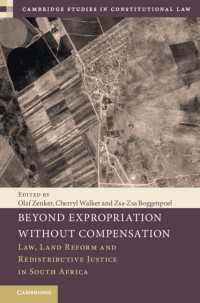- ホーム
- > 洋書
- > 英文書
- > History / World
基本説明
Winner of the 2003 Bancroft Prize.
Full Description
Winner of the 2003 Bancroft Prize
"No one will again be able to deny the significance of Indian slavery in the story of early America or its devastating impact on Native American people."—Daniel K. Richter, American Historical Review
This absorbing book focuses on the traffic in Indian slaves during the early years of the American South. The Indian slave trade was of central importance from the Carolina coast to the Mississippi Valley for nearly fifty years, linking southern lives and creating a whirlwind of violence and profit-making, argues Alan Gallay. He documents in vivid detail how the trade operated, the processes by which Europeans and Native Americans became participants, and the profound consequences for the South and its peoples.
The author places Native Americans at the center of the story of European colonization and the evolution of plantation slavery in America. He explores the impact of such contemporary forces as the African slave trade, the unification of England and Scotland, and the competition among European empires as well as political and religious divisions in England and in South Carolina. Gallay also analyzes how Native American societies approached warfare, diplomacy, and decisions about allying and trading with Europeans. His wide-ranging research not only illuminates a crucial crossroad of European and Native American history but also establishes a new context for understanding racism, colonialism, and the meaning of ethnicity in early America.
-

- 洋書
- My Pastor
-

- 洋書電子書籍
- Beyond Expropriatio…




